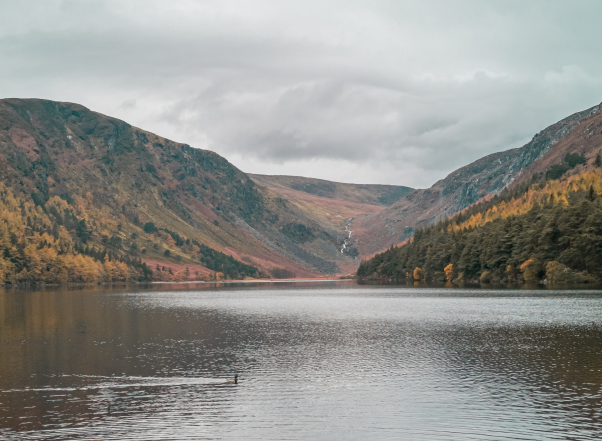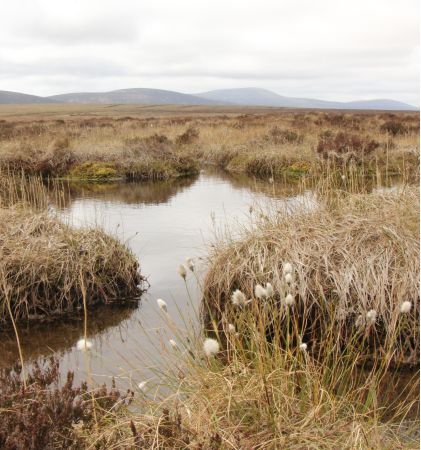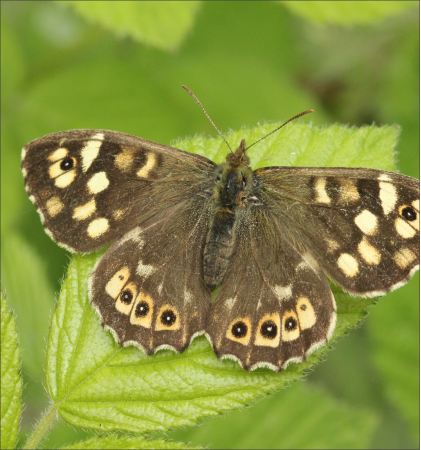Nature & Conservation
Wicklow Mountains National Park and its habitats are protected by law. In addition to these laws, there are certain guidelines that must be followed to ensure that all visitors enjoy their visit.

Discover how you can help us conserve the park’s biodiversity and landscape, or plan your visit to explore the uplands on a hike or scenic drive. A true flavour of Ireland’s ancient wilderness awaits you in the park.

Thank you for helping us protect nature at Wicklow Mountains National Park. When you enjoy responsible outdoor recreation here, you help us preserve the unique creatures and habitats of the Wicklow Mountains.
Protected Species
Ireland’s species and habitats are protected under a range of national and EU legislation. The Wildlife Act, 1976, is the principal national legislation providing for the protection of wildlife and the control of some activities that may adversely affect wildlife.
The Protected Species list is not exclusive. Other rare and protected species may also occur within the park.
Flora
Here in Wicklow Mountains National Park, we have a variety of species, from heathers and gorse dominating the mountain sides, to bogland species such as sundews.
This native plant is mostly found amongst the woodlands of the National Park, but can also be found on moss-covered trees and shaded walls. Visitors are most likely to spot this flower in the spring and summer seasons, as it blooms from April to June.
Bilberries are commonly found on acid heathland and damp mountainsides. You can see these wildflowers primarily in the spring and summer, from April to July. In autumn, this plant bears purple-black berries with a blue bloom.
Bilberries are also commonly known as fraughan, whortleberry, blaeberry, huckleberry and whinberry. Please do not forage these plants. Leave them for birds and animals.
Sources: Wildflowers of Ireland
This flower can typically be found in the woodlands of the National Park, as well as by rivers. One of the first flowers to bloom in the colder seasons, this flower can be seen from February to May. One of Ireland’s native wildflowers, it is an important nectar source for woodland pollinators in early spring.
This plant can be found amongst the wetlands of the National Park. It dwells within shallow, still or slow-moving water, with its leaves and flowers floating on the surface.
Gorse is Ireland’s most distinctive native shrub. Throughout the year, the rich yellow peaflowers can’t be missed across the Irish landscape. The shrub has adapted and modified to withstand the conditions of winter, particularly amongst the high mountains of Ireland, making itself a bundle of prickles and spines. The flowers on the shrub bloom in abundance from February to May.
This native tree is similar to the silver birch tree, but has creamy-brown bark rather than white and more upright branches. It thrives in damp environments and is commonly found in boglands. As the tree comes into leaf, long greenish-brown male catkins appear. The female flowers are upright in contrast, and they release small winged seeds in the autumn.
There are several native species of heather in Ireland. This one is Ling Heather. Heather bloom from June to September. Although the heather within the National Park is predominately found in shades of purple/red, keep an eye out for white heather, as it is considered lucky to find.
Heather has been used for a variety of purposes throughout history, such as flavouring for beer.
Small White Orchid is a protected flora species that grows in mountain grassland and on rock ledges. This protected species flowers from May to July. If you’re lucky enough to spot this rare plant, try leaning closer to take in the vanilla aroma. If you do sight this flower, please keep in mind our Protect Nature code and be mindful of it and other flora that may surround it.
Sources: Wildflowers of Ireland
This plant can be seen blooming from June to August. This plant is commonly found on boggy ground and wet heaths throughout the National Park. Due to this type of habitat, there are very little nutrients to support this plant and it has adapted to other methods. On the leaves you can see hairs with a little drop of ‘dew’. This is what captures the insects, which the sundew then turns into their food. In the past, sundews were used as a cough remedy and it is now used in many cough mixtures we know and use today.
Habitats
Wicklow Mountains National Park supports a number of important habitat types, ranging from blanket bog and oak woodland to corrie lakes and old lead mine workings. Wet and dry heath, blanket bog and upland grassland are the dominant habitats throughout most of the National Park. Soils are acidic, usually peaty. Typical plants include heathers, bilberry and grasses in the drier areas, with sphagnum mosses and insectivorous sundews in the boggier areas of the National Park.
Woodlands
Small areas of oak woodland occur on the slopes of Glendalough and Glenmalure, near Lough Tay and Lough Dan, with native sessile oak (Quercus petraea), many of which are 100-120 years old.
On wetter areas, wet broadleaved semi-natural woodlands occur, dominated by downy birch (Betula pubescens). There’s also mixed woodland, with non-native tree species.
Lakes and Streams
Mountain loughs and corrie lakes are scattered throughout the site, often with adjourning scree cliffs. The lakes tend to be deep and nutrient poor but hold some interesting plants, including quillwort (Isoetes lacustris) and floating bur-reed (Sparganium angustifolium). Rocky mountain streams are common throughout the hills.
Liffey Head Bog

Several rivers start their journey here, including the Liffey, the Dargle, and the Dodder, making this bog vital for Dublin’s water supply. At first glance Liffey Head Bog can look featureless and devoid of life. But a close inspection will reveal a matrix of dry hummocks and wet flushes, each with their own flora and fauna. Small insectivorous plants such as sundews are common.
Fauna
Here in Wicklow Mountains National Park, we have special species, such as peregrine falcon, merlin, goosanders, whinchat, red grouse and pine marten.
Many bird species live in the Wicklow Mountains, although they can be hard to spot in the vast expanses of mountain bog or the dense foliage of the woodlands. Species of particular interest include merlin, goosander, whinchat and red grouse.
One notable bird to spot is the peregrine falcon, which is the symbol of the National Park.
Other birds to watch out for include great spotted woodpecker, rare summer visitors such as wood warbler and the redstart, as well as snipe, skylark and stonechat.
Mammals such as rabbits, hares, foxes, goats, badgers, pine marten, stoats, and otters can be found in the park. The park is also home to at least nine species of bats, which are often observed at night.
Deer are the largest mammals in the Park. A large population of Red-Sika hybrids live in the hills. Sika deer were introduced from Asia in the past, and have hybridised freely with our native Red deer.
Due to location and climate, Ireland has a limited number of reptile and amphibian species. Just one species of frog (the Common Frog), one species of newt (the Smooth Newt) and one species of reptile (the Common Lizard) live in the National Park.
Noteworthy Species
The peregrine falcon is the symbol of Wicklow Mountains National Park. It nests on cliffs throughout the park. The population is monitored annually by park staff. Peregrines are often spotted flying high over the National Park – keep your ears open and look up if you hear their high-pitched call.
Ireland’s smallest bird of prey, the merlin lives in the uplands and hunts over open moorland and bog. It usually nests in trees at the edge of a plantation. It is amber listed in Ireland. With binoculars, it is worth scanning any post or boulder that stands up above the flat moorland terrain; merlins like to perch on such high spots.
This large, fish-eating duck is very rare in Ireland, with resident populations only in counties Wicklow and Donegal. It is a tree-nesting species and breeds in low numbers in Glendalough and the Avonmore river system. Breeding success has increased following the instigation of a nest box scheme by park rangers.
Early morning visitors to Glendalough sometimes see a family group of goosanders in the Upper or Lower Lake, but they are wary and will fly off if approached. The males are recognisable by their green head. Female and young birds have a brown head and are known as ‘redheads’.
The whinchat is a summer visitor to Ireland. It breeds in upland areas, but its population is declining. Similar in size to its cousin, the stonechat, the whinchat is always a joy to see. Within the National Park, Coronation Plantation is a good place to look for this rare species.
The red grouse is a bird of heather moorland and requires heather of various ages for food, shelter and nest cover. Hill walkers in the National Park often meet grouse. In spring and early summer the distinctive ‘go back, go back’ call of the males can often be heard.
The red grouse is red listed, which means it is of high conservation concern. If you do meet grouse in the hills, especially during breeding season, please try not to disturb them. Keep dogs on leads at all times, and back off if the birds appear agitated.
The pine marten is native to Ireland and is one of our rarest mammals. Once common throughout the country, by the 20th century this species had become extinct from the majority of the island, surviving only in a few isolated and fragmented populations, mainly in the west. This decline was the result of hunting of martens for their fur, loss of habitat and both direct and indirect poisoning and persecution.
The pine marten is gradually recolonising Ireland and returning to areas where it has not been seen for decades.
Butterfly Safari
Ireland has 35 species of butterfly. Many of these can be spotted within Wicklow Mountains National Park, making it the perfect place for a butterfly safari.
You can start your safari in Glendalough. The lawns and woodland edges near the Upper Lake, the Wildlife and Sensory garden behind the National Park Information Office, and the Miners’ Village are great places to look. Here are some of the more unique species you might see.
Noteworthy Species
The silver-washed fritillary is Ireland’s largest butterfly and always a joy to see.
It is widely distributed but local in Ireland. It likes woodland edges and scrub. It is on the wing in July and August, and can be seen in Glendalough. Try looking in the garden behind the Information Office.
The dark green fritillary is very similar to the silver-washed fritillary and they are often mistaken for each other. The dark green is on the wing between June and September.
It is a declining species and is of conservation concern. It has a mainly coastal distribution, but is also found in the uplands and can be seen regularly at the Miners’ Village, often feeding on thistles.
The grayling is a master of disguise – and blends in seamlessly with the grey rocks. They are a late summer species, on the wing from July to September.
Populations of graylings are declining throughout Ireland and it is classified as near threatened. A colony of graylings at the Miners’ Village is monitored annually by National Park staff.
The small heath can also be found in the Miners’ Village. It is another declining species that is classed as near threatened. It is on the wing between June and September.

Some Common Species of Butterfly
Other species that you can see in the National Park include speckled wood, meadow brown, ringlet, green-veined white, orange tip, small and large whites, holly blue, peacock, small tortoiseshell, red admiral and painted lady. There have also been recent sightings of comma, a relatively new species to Ireland.
Geology
The uplands consist of a core of granite, flanked by metamorphic schists. The granite was extruded over 500 million years ago as two tectonic plates collided. The classic u-shaped valleys of Glendalough and Glenmalure, and the park’s high corrie lakes, moraines, erratics and hanging valleys, were all formed as a result of glacier movement during the Ice Age.









